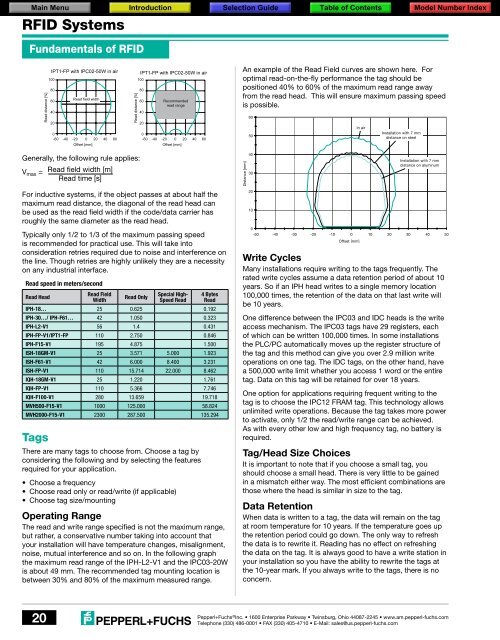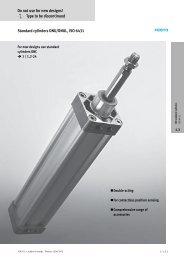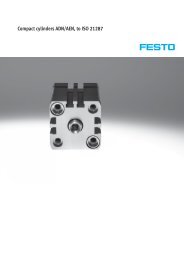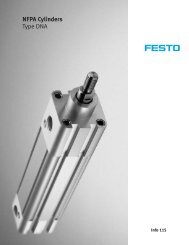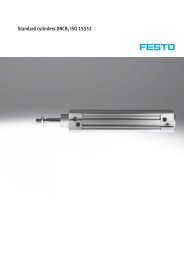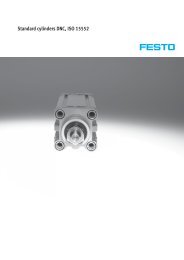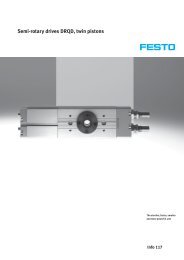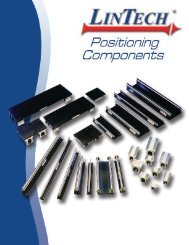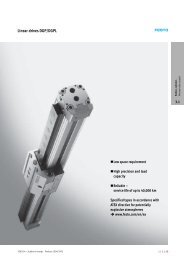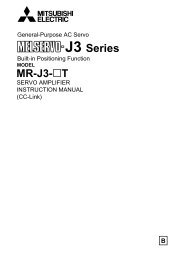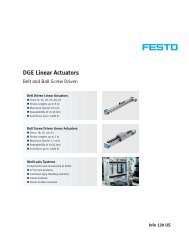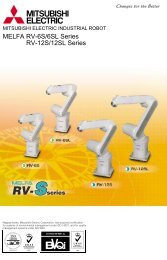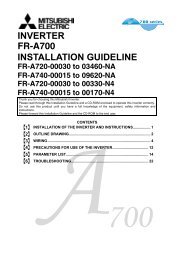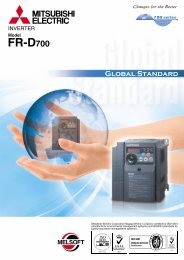RFID Systems - Allied Automation, Inc.
RFID Systems - Allied Automation, Inc.
RFID Systems - Allied Automation, Inc.
You also want an ePaper? Increase the reach of your titles
YUMPU automatically turns print PDFs into web optimized ePapers that Google loves.
<strong>RFID</strong> <strong>Systems</strong>Fundamentals of <strong>RFID</strong>Read distance [%]IPT1-FP with IPC02-50W in air10080604020Read field width0-60 -40 -20 0 20 40 60Offset [mm]Read distance [%]IPT1-FP with IPC02-50W in air10080604020Recommendedread range0-60 -40 -20 0 20 40 60Offset [mm]An example of the Read Field curves are shown here. Foroptimal read-on-the-fly performance the tag should bepositioned 40% to 60% of the maximum read range awayfrom the read head. This will ensure maximum passing speedis possible.6050In airInstallation with 7 mmdistance on steelGenerally, the following rule applies:V max = Read field width [m]Read time [s]Distance [mm]4030Installation with 7 mmdistance on aluminumFor inductive systems, if the object passes at about half themaximum read distance, the diagonal of the read head canbe used as the read field width if the code/data carrier hasroughly the same diameter as the read head.Typically only 1/2 to 1/3 of the maximum passing speedis recommended for practical use. This will take intoconsideration retries required due to noise and interference onthe line. Though retries are highly unlikely they are a necessityon any industrial interface.Read speed in meters/secondRead HeadRead FieldWidthRead OnlySpecial High-Speed Read4 Bytes ReadIPH-18… 25 0.625 0.192IPH-30…/ IPH-F61… 42 1.050 0.323IPH-L2-V1 56 1.4 0.431IPH-FP-V1/IPT1-FP 110 2.750 0.846IPH-F15-V1 195 4.875 1.500ISH-18GM-V1 25 3.571 5.000 1.923ISH-F61-V1 42 6.000 8.400 3.231ISH-FP-V1 110 15.714 22.000 8.462IQH-18GM-V1 25 1.220 1.761IQH-FP-V1 110 5.366 7.746IQH-F100-V1 280 13.659 19.718MVH500-F15-V1 1000 125.000 58.824MVH2000-F15-V1 2300 287.500 135.294TagsThere are many tags to choose from. Choose a tag byconsidering the following and by selecting the featuresrequired for your application.• Choose a frequency• Choose read only or read/write (if applicable)• Choose tag size/mountingOperating RangeThe read and write range specified is not the maximum range,but rather, a conservative number taking into account thatyour installation will have temperature changes, misalignment,noise, mutual interference and so on. In the following graphthe maximum read range of the IPH-L2-V1 and the IPC03-20Wis about 49 mm. The recommended tag mounting location isbetween 30% and 80% of the maximum measured range.20100-50 -40 -30 -20 -10 0 10 20 30 40 50Offset [mm]Write CyclesMany installations require writing to the tags frequently. Therated write cycles assume a data retention period of about 10years. So if an IPH head writes to a single memory location100,000 times, the retention of the data on that last write willbe 10 years.One difference between the IPC03 and IDC heads is the writeaccess mechanism. The IPC03 tags have 29 registers, eachof which can be written 100,000 times. In some installationsthe PLC/PC automatically moves up the register structure ofthe tag and this method can give you over 2.9 million writeoperations on one tag. The IDC tags, on the other hand, havea 500,000 write limit whether you access 1 word or the entiretag. Data on this tag will be retained for over 18 years.One option for applications requiring frequent writing to thetag is to choose the IPC12 FRAM tag. This technology allowsunlimited write operations. Because the tag takes more powerto activate, only 1/2 the read/write range can be achieved.As with every other low and high frequency tag, no battery isrequired.Tag/Head Size ChoicesIt is important to note that if you choose a small tag, youshould choose a small head. There is very little to be gainedin a mismatch either way. The most efficient combinations arethose where the head is similar in size to the tag.Data RetentionWhen data is written to a tag, the data will remain on the tagat room temperature for 10 years. If the temperature goes upthe retention period could go down. The only way to refreshthe data is to rewrite it. Reading has no effect on refreshingthe data on the tag. It is always good to have a write station inyour installation so you have the ability to rewrite the tags atthe 10-year mark. If you always write to the tags, there is noconcern.Pepperl+Fuchs®<strong>Inc</strong>. • 1600 Enterprise Parkway • Twinsburg, Ohio 44087-2245 • www.am.pepperl-fuchs.com20Telephone (330) 486-0001 • FAX (330) 405-4710 • E-Mail: sales@us.pepperl-fuchs.com


